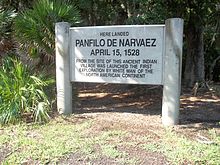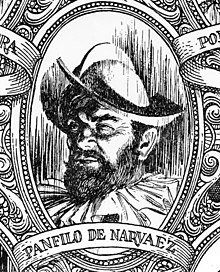| This article needs additional citations for verification. Please help improve this article by adding citations to reliable sources. Unsourced material may be challenged and removed. Find sources: "Pánfilo de Narváez" – news · newspapers · books · scholar · JSTOR (November 2021) (Learn how and when to remove this message) |
Pánfilo de Narváez (Spanish pronunciation: [ˈpaɱfilo ðe naɾˈβaeθ]; born 1470 or 1478, died 1528) was a Spanish conquistador and soldier in the Americas. Born in Spain, he first sailed to the island of Jamaica (then Santiago) in 1510 as a soldier. Pánfilo participated in the conquest of Cuba and led an expedition to Camagüey, escorting Bartolomé de las Casas.
He is best remembered as the leader of two failed expeditions, the first of which began in 1519 and ended in 1520 after defeat and capture in battle against Hernán Cortés. Pánfilo's second expedition, the Narváez expedition, began in 1527 and ended for him with his death the following year. Only four men returned from it, reaching present-day Mexico City in 1536. He was named an adelantado by King Carlos V before embarking on that final expedition.
Birth and family
Pánfilo de Narváez was born in Castile (in either Navalmanzano, near Cuéllar, or Valladolid) in 1470 or 1478. He was a relative of Diego Velázquez de Cuéllar, the first Spanish governor of Cuba. Pánfilo's nephew was Antonio Velázquez de Narváez. Bartolomé de las Casas described him as "a man of authoritative personality, tall of body and somewhat blonde inclined to redness".
Early years as conquistador
Narváez took part in the Spanish conquest of Jamaica in 1509. In 1511, he went to Cuba to participate in the conquest of that island under the command of Diego Velázquez de Cuéllar.
He led expeditions to the eastern end of the island in the company of Bartolomé de las Casas and Juan de Grijalva. De las Casas (who was an eyewitness) reported that Narváez presided over the massacre of Caonao, where Spanish troops killed a village full of natives who had come to meet them with food. After the massacre Narváez asked de las Casas, "What do you think about what our Spaniards have done?" De las Casas replied, "I send both you and them to the Devil!"
Expedition to Mexico
Diego Velázquez de Cuéllar, the governor of Cuba, sponsored Hernán Cortés to man an expedition to Mexico in 1519. With second thoughts about Cortés' loyalty, however, he recalled the expedition shortly after it began. Cortés disobeyed, proceeding with the expedition that would result in the Spanish conquest of the Aztec Empire. Narváez (arriving from Cuba) was named governor of Mexico by Velázquez, who sent him and 1,400 men on 19 ships to México to intercept Cortés.
Narváez disembarked at Veracruz, where Cortés had left a small garrison and set out with the rest of his men for the Aztec capital of Tenochtitlan. The garrison was manned by Cortés' captain, Gonzalo de Sandoval, who captured some of Narváez's men and sent them to Tenochtitlan to alert Cortés. Unable to defeat the garrison, Narváez went to the Totonac town of Cempoala and set up camp.
When news of Narváez's arrival reached Cortés, he gathered a contingent of his troops (perhaps as few as 250) and returned to the coast. Although his remaining 900 men outnumbered those of Cortés three to one, Narváez was outmanoeuvred, lost an eye and was taken prisoner in the Battle of Cempoala on May 27, 1520. After a two-year imprisonment, he was returned to Spain.
Expedition to Florida
Main article: Narváez expeditionWhen Narváez returned to Spain, he was appointed adelantado of Florida by Charles V and sent to colonize the territory. He embarked from Sanlúcar de Barrameda on June 17, 1527, with a fleet of five ships and 600 men. Narváez himself believed that there were other wealthy empires, like the Aztecs, up North.
After reaching Cuba and losing several ships in a hurricane, Narváez regrouped and set sail with five ships, 400 men, and 10 women for the Rio de las Palmas (near present-day Tampico) in February 1528. His fleet ran aground, and he decided to go to Havana to obtain additional supplies. Narváez was unable to reach Havana, as storms and strong winds forced him north to Florida's west coast. The expedition arrived there in April 1528, weakened by storms and desertions. Narváez landed with 300 men at the mouth of Boca Ciega Bay, north of Tampa Bay at the present-day Jungle Prada Site in St. Petersburg, among hostile natives.

He led an excursion inland, where he discovered the southern shore of present-day Old Tampa Bay. Narváez continued along its coastline and arrived at the main village of the Tocobaga Indians (present-day Safety Harbor), where he discovered "many boxes from Castile" and several European artefacts. Recent research suggests that he may have found the remnants of the 1521 settlement established and abandoned by Juan Ponce de León.
Finding their landing place unsuitable for settlement, Narváez ordered the expedition to split into 100 men and 10 women aboard ships and 300 men and 42 horses travelling by land. They planned to head north along the coast, planning to re-unite at a large bay that his pilots assured him was nearby. There was no large harbour north of their landing site, and Narváez never saw his ships again.
His expedition moved north until it reached the present-day St. Marks River, in the territory of the Apalachee people. Unable to find the gold and other riches he sought and tired of hostilities with the natives, Narváez ordered the construction of four rafts in an attempt to reach Pánuco (his original destination).
A storm drowned most of his remaining 240 men near Galveston Island, with only about 80 swept ashore. Narváez and a small group of men were carried out to sea and were never seen again.
Only four men survived the six years it took for the remainder of the expedition to find its way back. It was eight years from their initial landing in Florida before they arrived in Culiacán (Sinaloa), where they found Melchor Diaz mayor and captain of the province. Álvar Núñez Cabeza de Vaca, Andrés Dorantes de Carranza, Alonso del Castillo Maldonado and the Moroccan slave Estevanico (Esteban) had remained in captivity on (or near) Galveston Island for six years.
Cabeza de Vaca wrote a relación about the journey on foot by these four survivors across the present-day southwestern United States and northern Mexico. It was the first book describing the people, animals, flora and fauna of inland North America.
References
- ^ Alchin, Linda K., "Panfilo de Narvaez", Elizabethan Era, retrieved June 17, 2010
- ^ "The Misadventures of Pánfilo de Narváez and Nuñez de Cabeza de Vaca", A Short History of Florida, Tampa: University of South Florida, retrieved June 17, 2010
- Some sources give the year of birth as 1470 others as 1478
- ^ Martín Acosta, Emelina (2018). "Diccionario Biográfico electrónico". dbe.rah.es (in Spanish). Real Academia de la Historia. Retrieved August 16, 2023.
- Goodwyn, F. (1949). Pánfilo de Narváez, "A Character Study of the First Spanish Leader to Land an Expedition to Texas". The Hispanic American Historical Review, 29(1), 150–156.
- Floyd, Troy (1973). The Columbus Dynasty in the Caribbean, 1492–1526. Albuquerque: University of New Mexico Press. pp. 131, 164, 168.
- de las Casas, Bartolomé, Historia de las Indias (in Spanish), Book III, Ch. 29–30.
- ^ Diaz, B., 1963, The Conquest of New Spain, London: Penguin Books, ISBN 0140441239
- Reséndez, Andrés (2007). A Land So Strange: The Epic Journey of Cabeza de Vaca. New York: Basic Books. pp. 82. ISBN 978-0-465-06841-8.
- Oviedo y Valdez, G. F., & Davenport, H. (1923). "The Expedition of Pánfilo de Narváez". The Southwestern Historical Quarterly, 27(2), 120–139.
- ^ De Vaca, Alvar Nunez Cabeza (1993). Pupo-Walker, Enrique (ed.). Castaways, The Narrative of Alvar Nunez Cabeza De Vaca. Berkeley: University of California Press. p. 115. ISBN 0520070631.
Further reading
Library resources aboutPánfilo de Narváez
- Herrick, Dennis. Esteban: The African Slave Who Explored America. University of New Mexico Press: Albuquerque. 2018. ISBN 978-0-8263-5981-0
- Maura, Juan Francisco (2008) (in Spanish). "El Gran Burlador de Ámerica: Alvar Núñez Cabeza de Vaca". Parnaseo-Lemir. Valencia: Universidad de Valencia. ISSN 1579-735X.
- "Pánfilo de Narváez". Encyclopedia of World Biography. Vol. 11. 2nd ed. Detroit: Gale, 2004. p. 315.
- Reséndez, Andrés (2007). A Land So Strange: The Epic Journey of Cabeza de Vaca. Basic Books, Perseus. ISBN 978-0-465-06840-1
- Schneider, Paul (2006). Brutal Journey: The Epic Story of the First Crossing of North America. Henry Holt. ISBN 978-0-8050-6835-1
- Vigil, Ralph (1974). "A Reappraisal of the Expedition of Panfilo de Narvaez to Mexico in 1520". Revista de Historia de América (77/78): 101–125. ISSN 0034-8325. JSTOR 20139141.
External links
- "Cabeza de Vaca's Trail with Pánfilo de Narváez in North America"
- "Alvar Nuñez Cabeza de Vaca". The West. PBS.
- Biography of Pánfilo de Narváez. About.com.
- Historia de las Indias. Bartolome de las Casas.
- Shipwrecked by "Alvar Nuñez Cabeza de Vaca, and the Description of the Journey Which he Made Through Florida with Panfilo de Narvaez," from the World Digital Library

